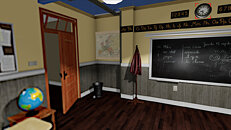- Joined
- Oct 9, 2007
- Messages
- 47,485 (7.49/day)
- Location
- Hyderabad, India
| System Name | RBMK-1000 |
|---|---|
| Processor | AMD Ryzen 7 5700G |
| Motherboard | ASUS ROG Strix B450-E Gaming |
| Cooling | DeepCool Gammax L240 V2 |
| Memory | 2x 8GB G.Skill Sniper X |
| Video Card(s) | Palit GeForce RTX 2080 SUPER GameRock |
| Storage | Western Digital Black NVMe 512GB |
| Display(s) | BenQ 1440p 60 Hz 27-inch |
| Case | Corsair Carbide 100R |
| Audio Device(s) | ASUS SupremeFX S1220A |
| Power Supply | Cooler Master MWE Gold 650W |
| Mouse | ASUS ROG Strix Impact |
| Keyboard | Gamdias Hermes E2 |
| Software | Windows 11 Pro |
NVIDIA's ANZ (Australia and New Zealand) Twitter handle posted a curious-looking teaser of something to look forward to on March 19. The now-deleted Tweet contained an animation showing the shape of an eye tracking two points of light crossing its iris. This date falls just a couple of days ahead of the March 22 debut of GTC 2020, the NVIDIA-promoted trade-show covering all things graphics tech. As many on the tweet and online forums discussing have pointed out, the announcement could probably be related to a commercial release of NVIDIA's foveated rendering technology that was demonstrated way back at SIGGRAPH 2016, at a time when VR and related technologies were all the rage.
The concept of foveated rendering is straightforward: eye-tracking is leveraged to ensure that areas of the frame you're looking at are rendered in greater detail than the others, to conserve system resources and improve performance. This is achieved by tracking your foveal vision (the primary part of your vision focused on detail), while shedding resources on parts of the frame that fall within your peripheral vision. Compared to 2016, rendering technologies to facilitate foveated rendering have advanced. A related technology is variable shading rate (VRS), which allows an application to render different parts of the scene at different levels of detail, and improve performance.


A video presentation detailing NVIDIA's foveated rendering tech from 2016 follows.
View at TechPowerUp Main Site
The concept of foveated rendering is straightforward: eye-tracking is leveraged to ensure that areas of the frame you're looking at are rendered in greater detail than the others, to conserve system resources and improve performance. This is achieved by tracking your foveal vision (the primary part of your vision focused on detail), while shedding resources on parts of the frame that fall within your peripheral vision. Compared to 2016, rendering technologies to facilitate foveated rendering have advanced. A related technology is variable shading rate (VRS), which allows an application to render different parts of the scene at different levels of detail, and improve performance.


A video presentation detailing NVIDIA's foveated rendering tech from 2016 follows.
View at TechPowerUp Main Site








